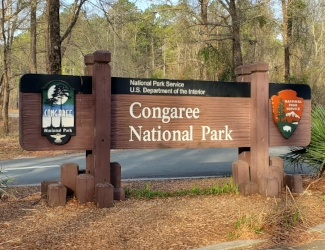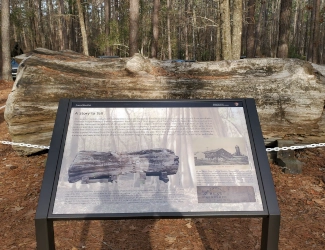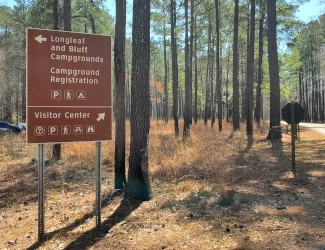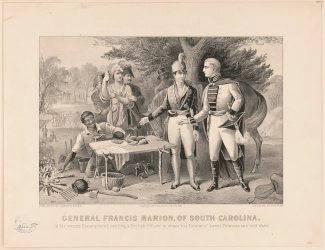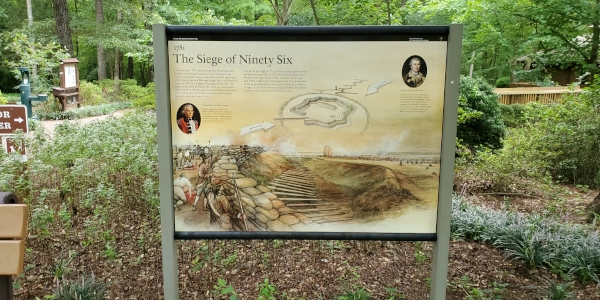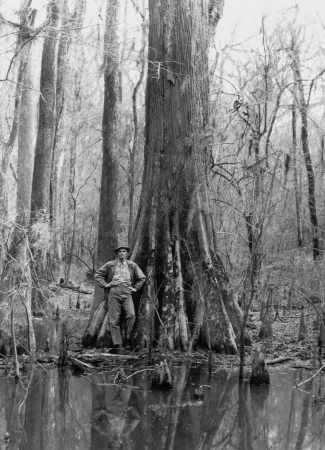
Vintage photo of Harry Hampton standing beside the trunk of one of the large bald cypress trees, one hundred and thirty-five feet for this one, in Congaree National Park, 1950's. Courtesy National Park Service. Right: Part of the two and one half mile boardwalk amongst the large trees at Congaree National Park, 2025, America's Best History.
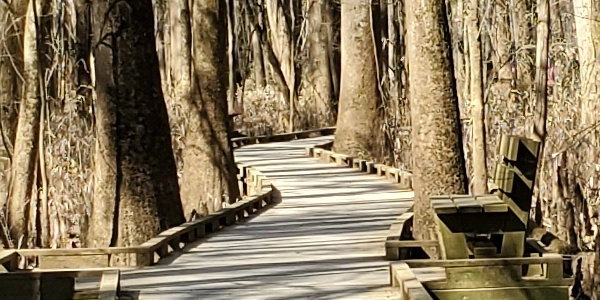
Congaree National Park
When there used to be thirty-one million acres of old-growth flood plain hardwood forest in the United States, and now there is little more than just the twenty-seven thousand at Congaree National Park and a couple thousand here and there about the United States, you'd think it should be very important to keep it safe. And that is what Harry Hampton did, campaigning for National Monument status in the 1950's, until it was recognized as such in 1976. It has been updated to National Park status and there's nothing like it. Huge trees, some one hundred and seventy-five feet tall, including Bald Cypress, Maple, and Tupelo, spread about the park where little, to no, development has touched. You can only access the interior by foot or water. The park road takes you to the Visitor Center, with one side road near there to the kayak launch. Another kayak launch and parts of the park are off of Route 601, but the Harry Hampton Visitor Center is where it all starts.
Click here to Sponsor the page and how to reserve your ad.
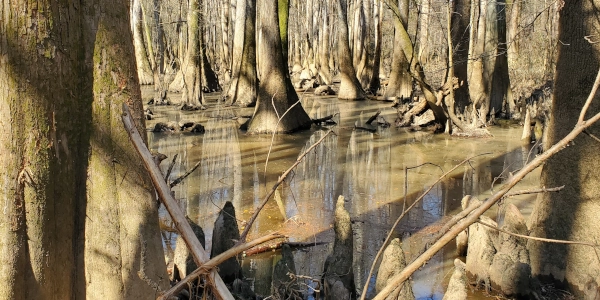
Congaree National Park Then
Fortunately for us, the Congaree River area, and specifically its floodplain that is the acreage of the park, is very similar to how it has been for the thousands of years that man has been engaged with it. Of course, during glacial times, you couldn't say that. There were more lakes then, some of which the guides can point out and prove. The actual Congaree River is not long, only fifty-three miles, and the Congaree Indians were some of its first inhabitants in this area of the Southern Woodlands. They merged, I guess you'd call it that, with the Catawba and Wateree after a temporary move to the Waccamaw River in 1732. They had lost much of their population to smallpox in 1698, their village then consisting of only about one dozen houses.
Image above: Some of the Congaree swamp just off the boardwalk with thick tree trunks of some "knees", i.e. roots that grow straight up around the trees, 2025, America's Best History. Below: Kayaks readying to go on a river adventure. These are run by private outfitters and during a few weekends, by the Park Service rangers themselves, 2025, America's Best History.
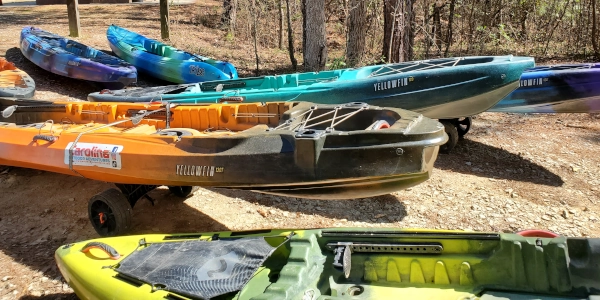
Congaree National Park Now
The area, as noted above, is very similar in geography and plants and trees to that of historic times. The area has been lucky that it has remained undeveloped, mainly due to its continuous flooding from the Congaree and Santee rivers. However, with its National Park status upgrade in 2001, it has allowed a vast wilderness area to explore. And guided tours plus self-guided tours of the Boardwalk Trail, which is predominantly flat and easy for most to navigate and follow. Two small campgrounds exist as well. This is nature that deserves to be preserved. Thankfully, it is, but it also deserves to be visited more highly.
Minute Walk in History
Take this walk with us with National Park staff and see the wonders of the only substantial remaining hardwood forest in a flood plan, Congaree River, in the United States. Of the 30 million acres, the 26,000 acres here is almost all that is left. You will see and hear of its history, walking predominantly on boardwalk trails over two miles long, because there are times the river inundates the area. Congaree was also the place where people went to hide, including Francis Marion, the Revolutionary War hero, and escaped slaves. This park is just one example of the reason why cuts to the National Park Service by President Trump should not occur.
T-Shirts and Souvenirs

Congaree National Park T-Shirts and Souvenirs.
Congaree National Park
Things You Should Not Miss
1. Start your visit at the Harry Hampton Visitor Center, particularly if this is your first visit. The boardwalk trail emanates from there, and Rangers and facilities provide necessary amenaties to a good hike or 17 minute movie.
2. Walk the 2.4 mile interpretive Boardwalk Trail. In winter, it is often a sunny amble through tall trees with the swamp beneath you, either low or near the walkway. If its above, you can't go. For those with the ability to hike further, take plenty of water and good hiking shoes. A summer day can bring hot temperatures, although the tree canopy is so thick then that there is a coolness below the average temperature in the area most days.
3. Okay, just go kayaking. Hire an adventure guide. They are advertised in the area. Or if you are lucky to get a Ranger Guided kayak tour available on the day you visit, don't miss it.
Visitor FAQ
Nearby Attractions
Cowpens National Battlefield
Kings Mountain
Battle of Ninety-Six
South Carolina Tourism
